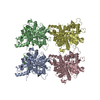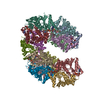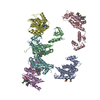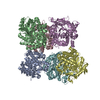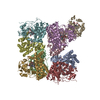[English] 日本語
 Yorodumi
Yorodumi- EMDB-5981: Cryo-Electron Microscopy Reconstruction of Glucocorticoid Recepto... -
+ Open data
Open data
- Basic information
Basic information
| Entry | Database: EMDB / ID: EMD-5981 | |||||||||
|---|---|---|---|---|---|---|---|---|---|---|
| Title | Cryo-Electron Microscopy Reconstruction of Glucocorticoid Receptor-bound Hsp90-Hsp70-Hop Chaperone Complex | |||||||||
 Map data Map data | Reconstruction of client-bound Hsp90-Hsp70-Hop chaperone complex | |||||||||
 Sample Sample |
| |||||||||
 Keywords Keywords |  Hsp90 / Hsp90 /  Hsp70 / Hop / Hsp70 / Hop /  Glucocorticoid Receptor Glucocorticoid Receptor | |||||||||
| Function / homology |  Function and homology information Function and homology information: / Regulation of NPAS4 gene transcription / cellular heat acclimation / regulation of glucocorticoid biosynthetic process / nuclear glucocorticoid receptor activity / negative regulation of inclusion body assembly / positive regulation of nucleotide-binding oligomerization domain containing 2 signaling pathway / : / dynein axonemal particle / C3HC4-type RING finger domain binding ...: / Regulation of NPAS4 gene transcription / cellular heat acclimation / regulation of glucocorticoid biosynthetic process / nuclear glucocorticoid receptor activity / negative regulation of inclusion body assembly / positive regulation of nucleotide-binding oligomerization domain containing 2 signaling pathway / : / dynein axonemal particle / C3HC4-type RING finger domain binding /  steroid hormone binding / PTK6 Expression / ATP-dependent protein disaggregase activity / glucocorticoid metabolic process / positive regulation of microtubule nucleation / neuroinflammatory response / microglia differentiation / steroid hormone binding / PTK6 Expression / ATP-dependent protein disaggregase activity / glucocorticoid metabolic process / positive regulation of microtubule nucleation / neuroinflammatory response / microglia differentiation /  maternal behavior / mammary gland duct morphogenesis / nucleus localization / maternal behavior / mammary gland duct morphogenesis / nucleus localization /  misfolded protein binding / misfolded protein binding /  regulation of mitotic spindle assembly / positive regulation of tumor necrosis factor-mediated signaling pathway / astrocyte differentiation / protein folding chaperone complex / cellular response to interleukin-7 / cellular response to glucocorticoid stimulus / regulation of mitotic spindle assembly / positive regulation of tumor necrosis factor-mediated signaling pathway / astrocyte differentiation / protein folding chaperone complex / cellular response to interleukin-7 / cellular response to glucocorticoid stimulus /  aggresome / RND1 GTPase cycle / aggresome / RND1 GTPase cycle /  motor behavior / sperm mitochondrial sheath / motor behavior / sperm mitochondrial sheath /  dATP binding / Scavenging by Class F Receptors / dATP binding / Scavenging by Class F Receptors /  sulfonylurea receptor binding / CTP binding / positive regulation of protein polymerization / vRNP Assembly / UTP binding / sperm plasma membrane / positive regulation of tau-protein kinase activity / protein insertion into mitochondrial outer membrane / sulfonylurea receptor binding / CTP binding / positive regulation of protein polymerization / vRNP Assembly / UTP binding / sperm plasma membrane / positive regulation of tau-protein kinase activity / protein insertion into mitochondrial outer membrane /  regulation of gluconeogenesis / adrenal gland development / regulation of gluconeogenesis / adrenal gland development /  telomerase holoenzyme complex assembly / telomerase holoenzyme complex assembly /  chaperone-mediated autophagy / Rho GDP-dissociation inhibitor binding / cellular response to steroid hormone stimulus / Uptake and function of diphtheria toxin / mitochondrial transport / Drug-mediated inhibition of ERBB2 signaling / Resistance of ERBB2 KD mutants to trastuzumab / Resistance of ERBB2 KD mutants to sapitinib / Resistance of ERBB2 KD mutants to tesevatinib / Resistance of ERBB2 KD mutants to neratinib / Resistance of ERBB2 KD mutants to osimertinib / Resistance of ERBB2 KD mutants to afatinib / Resistance of ERBB2 KD mutants to AEE788 / Resistance of ERBB2 KD mutants to lapatinib / chaperone-mediated autophagy / Rho GDP-dissociation inhibitor binding / cellular response to steroid hormone stimulus / Uptake and function of diphtheria toxin / mitochondrial transport / Drug-mediated inhibition of ERBB2 signaling / Resistance of ERBB2 KD mutants to trastuzumab / Resistance of ERBB2 KD mutants to sapitinib / Resistance of ERBB2 KD mutants to tesevatinib / Resistance of ERBB2 KD mutants to neratinib / Resistance of ERBB2 KD mutants to osimertinib / Resistance of ERBB2 KD mutants to afatinib / Resistance of ERBB2 KD mutants to AEE788 / Resistance of ERBB2 KD mutants to lapatinib /  Drug resistance in ERBB2 TMD/JMD mutants / PIWI-interacting RNA (piRNA) biogenesis / TPR domain binding / mRNA catabolic process / Drug resistance in ERBB2 TMD/JMD mutants / PIWI-interacting RNA (piRNA) biogenesis / TPR domain binding / mRNA catabolic process /  non-chaperonin molecular chaperone ATPase / regulation of postsynaptic membrane neurotransmitter receptor levels / dendritic growth cone / chaperone cofactor-dependent protein refolding / Sema3A PAK dependent Axon repulsion / regulation of protein ubiquitination / positive regulation of cell size / skeletal muscle contraction / protein unfolding / regulation of protein-containing complex assembly / HSF1-dependent transactivation / telomere maintenance via telomerase / response to unfolded protein / negative regulation of extrinsic apoptotic signaling pathway in absence of ligand / Regulation of HSF1-mediated heat shock response / HSF1 activation / chaperone-mediated protein complex assembly / Attenuation phase / cellular response to unfolded protein / non-chaperonin molecular chaperone ATPase / regulation of postsynaptic membrane neurotransmitter receptor levels / dendritic growth cone / chaperone cofactor-dependent protein refolding / Sema3A PAK dependent Axon repulsion / regulation of protein ubiquitination / positive regulation of cell size / skeletal muscle contraction / protein unfolding / regulation of protein-containing complex assembly / HSF1-dependent transactivation / telomere maintenance via telomerase / response to unfolded protein / negative regulation of extrinsic apoptotic signaling pathway in absence of ligand / Regulation of HSF1-mediated heat shock response / HSF1 activation / chaperone-mediated protein complex assembly / Attenuation phase / cellular response to unfolded protein /  estrogen response element binding / FOXO-mediated transcription of oxidative stress, metabolic and neuronal genes / RHOBTB2 GTPase cycle / estrogen response element binding / FOXO-mediated transcription of oxidative stress, metabolic and neuronal genes / RHOBTB2 GTPase cycle /  DNA polymerase binding / positive regulation of lamellipodium assembly / axonal growth cone / eNOS activation / intracellular steroid hormone receptor signaling pathway / ATP metabolic process / protein folding chaperone / DNA polymerase binding / positive regulation of lamellipodium assembly / axonal growth cone / eNOS activation / intracellular steroid hormone receptor signaling pathway / ATP metabolic process / protein folding chaperone /  inclusion body / core promoter sequence-specific DNA binding / endocytic vesicle lumen / Tetrahydrobiopterin (BH4) synthesis, recycling, salvage and regulation / negative regulation of protein ubiquitination / positive regulation of defense response to virus by host / Loss of Nlp from mitotic centrosomes / Loss of proteins required for interphase microtubule organization from the centrosome / positive regulation of cardiac muscle contraction inclusion body / core promoter sequence-specific DNA binding / endocytic vesicle lumen / Tetrahydrobiopterin (BH4) synthesis, recycling, salvage and regulation / negative regulation of protein ubiquitination / positive regulation of defense response to virus by host / Loss of Nlp from mitotic centrosomes / Loss of proteins required for interphase microtubule organization from the centrosome / positive regulation of cardiac muscle contractionSimilarity search - Function | |||||||||
| Biological species |   Homo sapiens (human) Homo sapiens (human) | |||||||||
| Method |  single particle reconstruction / single particle reconstruction /  cryo EM / Resolution: 38.0 Å cryo EM / Resolution: 38.0 Å | |||||||||
 Authors Authors | Kirschke E / Goswami D / Southworth DR / Griffin PR / Agard DA | |||||||||
 Citation Citation |  Journal: Cell / Year: 2014 Journal: Cell / Year: 2014Title: Glucocorticoid receptor function regulated by coordinated action of the Hsp90 and Hsp70 chaperone cycles. Authors: Elaine Kirschke / Devrishi Goswami / Daniel Southworth / Patrick R Griffin / David A Agard /  Abstract: The glucocorticoid receptor (GR), like many signaling proteins, depends on the Hsp90 molecular chaperone for in vivo function. Although Hsp90 is required for ligand binding in vivo, purified apo GR ...The glucocorticoid receptor (GR), like many signaling proteins, depends on the Hsp90 molecular chaperone for in vivo function. Although Hsp90 is required for ligand binding in vivo, purified apo GR is capable of binding ligand with no enhancement from Hsp90. We reveal that Hsp70, known to facilitate client delivery to Hsp90, inactivates GR through partial unfolding, whereas Hsp90 reverses this inactivation. Full recovery of ligand binding requires ATP hydrolysis on Hsp90 and the Hop and p23 cochaperones. Surprisingly, Hsp90 ATP hydrolysis appears to regulate client transfer from Hsp70, likely through a coupling of the two chaperone's ATP cycles. Such coupling is embodied in contacts between Hsp90 and Hsp70 in the GR:Hsp70:Hsp90:Hop complex imaged by cryoelectron microscopy. Whereas GR released from Hsp70 is aggregation prone, release from Hsp90 protects GR from aggregation and enhances its ligand affinity. Together, this illustrates how coordinated chaperone interactions can enhance stability, function, and regulation. | |||||||||
| History |
|
- Structure visualization
Structure visualization
| Movie |
 Movie viewer Movie viewer |
|---|---|
| Structure viewer | EM map:  SurfView SurfView Molmil Molmil Jmol/JSmol Jmol/JSmol |
| Supplemental images |
- Downloads & links
Downloads & links
-EMDB archive
| Map data |  emd_5981.map.gz emd_5981.map.gz | 3.7 MB |  EMDB map data format EMDB map data format | |
|---|---|---|---|---|
| Header (meta data) |  emd-5981-v30.xml emd-5981-v30.xml emd-5981.xml emd-5981.xml | 13.9 KB 13.9 KB | Display Display |  EMDB header EMDB header |
| Images |  emd_5981.png emd_5981.png | 73.2 KB | ||
| Archive directory |  http://ftp.pdbj.org/pub/emdb/structures/EMD-5981 http://ftp.pdbj.org/pub/emdb/structures/EMD-5981 ftp://ftp.pdbj.org/pub/emdb/structures/EMD-5981 ftp://ftp.pdbj.org/pub/emdb/structures/EMD-5981 | HTTPS FTP |
-Related structure data
| Similar structure data |
|---|
- Links
Links
| EMDB pages |  EMDB (EBI/PDBe) / EMDB (EBI/PDBe) /  EMDataResource EMDataResource |
|---|---|
| Related items in Molecule of the Month |
- Map
Map
| File |  Download / File: emd_5981.map.gz / Format: CCP4 / Size: 6.4 MB / Type: IMAGE STORED AS FLOATING POINT NUMBER (4 BYTES) Download / File: emd_5981.map.gz / Format: CCP4 / Size: 6.4 MB / Type: IMAGE STORED AS FLOATING POINT NUMBER (4 BYTES) | ||||||||||||||||||||||||||||||||||||||||||||||||||||||||||||||||||||
|---|---|---|---|---|---|---|---|---|---|---|---|---|---|---|---|---|---|---|---|---|---|---|---|---|---|---|---|---|---|---|---|---|---|---|---|---|---|---|---|---|---|---|---|---|---|---|---|---|---|---|---|---|---|---|---|---|---|---|---|---|---|---|---|---|---|---|---|---|---|
| Annotation | Reconstruction of client-bound Hsp90-Hsp70-Hop chaperone complex | ||||||||||||||||||||||||||||||||||||||||||||||||||||||||||||||||||||
| Voxel size | X=Y=Z: 2.4 Å | ||||||||||||||||||||||||||||||||||||||||||||||||||||||||||||||||||||
| Density |
| ||||||||||||||||||||||||||||||||||||||||||||||||||||||||||||||||||||
| Symmetry | Space group: 1 | ||||||||||||||||||||||||||||||||||||||||||||||||||||||||||||||||||||
| Details | EMDB XML:
CCP4 map header:
| ||||||||||||||||||||||||||||||||||||||||||||||||||||||||||||||||||||
-Supplemental data
- Sample components
Sample components
-Entire : Human chaperones Hsp90 and Hsp70 bound with the human co-chaperon...
| Entire | Name: Human chaperones Hsp90 and Hsp70 bound with the human co-chaperone Hop and the ligand binding domain of the human glucocorticoid receptor N-terminally fused with the maltose binding protein |
|---|---|
| Components |
|
-Supramolecule #1000: Human chaperones Hsp90 and Hsp70 bound with the human co-chaperon...
| Supramolecule | Name: Human chaperones Hsp90 and Hsp70 bound with the human co-chaperone Hop and the ligand binding domain of the human glucocorticoid receptor N-terminally fused with the maltose binding protein type: sample / ID: 1000 Details: Complex was purified using size exclusion chromatography. Oligomeric state: One homodimer of Hsp90 bound to one Hsp70, one Hop, and one MBP-GRLBD Number unique components: 4 |
|---|---|
| Molecular weight | Theoretical: 380 KDa |
-Macromolecule #1: Heat shock protein 90-alpha
| Macromolecule | Name: Heat shock protein 90-alpha / type: protein_or_peptide / ID: 1 / Name.synonym: Hsp90 / Number of copies: 1 / Oligomeric state: Dimer / Recombinant expression: Yes |
|---|---|
| Source (natural) | Organism:   Homo sapiens (human) / synonym: Human Homo sapiens (human) / synonym: Human |
| Molecular weight | Theoretical: 84.66 KDa |
| Recombinant expression | Organism:   Escherichia coli (E. coli) / Recombinant strain: BL21 / Recombinant plasmid: pET151-D Escherichia coli (E. coli) / Recombinant strain: BL21 / Recombinant plasmid: pET151-D |
| Sequence | UniProtKB:  Heat shock protein HSP 90-alpha / InterPro: Heat shock protein HSP 90-alpha / InterPro:  Heat shock protein Hsp90 family Heat shock protein Hsp90 family |
-Macromolecule #2: Heat shock 70 kDa protein
| Macromolecule | Name: Heat shock 70 kDa protein / type: protein_or_peptide / ID: 2 / Name.synonym: Hsp70 / Number of copies: 1 / Oligomeric state: monomer / Recombinant expression: Yes |
|---|---|
| Source (natural) | Organism:   Homo sapiens (human) / synonym: Human Homo sapiens (human) / synonym: Human |
| Molecular weight | Theoretical: 70.052 KDa |
| Recombinant expression | Organism:   Spodoptera frugiperda (fall armyworm) / Recombinant cell: Sf9 Spodoptera frugiperda (fall armyworm) / Recombinant cell: Sf9 |
| Sequence | UniProtKB: Heat shock 70 kDa protein 1B / InterPro:  Heat shock protein 70 family Heat shock protein 70 family |
-Macromolecule #3: Glucocorticoid Receptor Ligand Binding Domain
| Macromolecule | Name: Glucocorticoid Receptor Ligand Binding Domain / type: protein_or_peptide / ID: 3 / Name.synonym: GRLBD Details: Maltose Binding Protein (MBP) tag attached to N-terminus Number of copies: 1 / Oligomeric state: monomer / Recombinant expression: Yes |
|---|---|
| Source (natural) | Organism:   Homo sapiens (human) / synonym: Human Homo sapiens (human) / synonym: Human |
| Molecular weight | Theoretical: 74.926 KDa |
| Recombinant expression | Organism:   Escherichia coli (E. coli) / Recombinant strain: BL21 / Recombinant plasmid: pMal Escherichia coli (E. coli) / Recombinant strain: BL21 / Recombinant plasmid: pMal |
| Sequence | UniProtKB:  Glucocorticoid receptor / InterPro: Glucocorticoid receptor / InterPro:  Glucocorticoid receptor Glucocorticoid receptor |
-Macromolecule #4: Stress-induced-phosphoprotein 1
| Macromolecule | Name: Stress-induced-phosphoprotein 1 / type: protein_or_peptide / ID: 4 / Name.synonym: Hop / Number of copies: 1 / Oligomeric state: monomer / Recombinant expression: Yes |
|---|---|
| Source (natural) | Organism:   Homo sapiens (human) / synonym: Human Homo sapiens (human) / synonym: Human |
| Molecular weight | Theoretical: 62.639 KDa |
| Recombinant expression | Organism:   Escherichia coli (E. coli) / Recombinant strain: BL21 / Recombinant plasmid: pET151-D Escherichia coli (E. coli) / Recombinant strain: BL21 / Recombinant plasmid: pET151-D |
| Sequence | UniProtKB: Stress-induced-phosphoprotein 1 / InterPro: Heat shock chaperonin-binding |
-Experimental details
-Structure determination
| Method |  cryo EM cryo EM |
|---|---|
 Processing Processing |  single particle reconstruction single particle reconstruction |
| Aggregation state | particle |
- Sample preparation
Sample preparation
| Buffer | pH: 7.5 Details: 50 mM HEPES, 50 mM KCl, 2 mM DTT, 5 mM MgCl2, 0.2 mM ADP |
|---|---|
| Grid | Details: C-flat holey carbon grid, 2 micron hole, 0.5 micron space |
| Vitrification | Cryogen name: ETHANE / Chamber humidity: 70 % / Chamber temperature: 75 K / Instrument: FEI VITROBOT MARK I / Method: two one-second blots before plunging |
- Electron microscopy
Electron microscopy
| Microscope | FEI TECNAI F20 |
|---|---|
| Electron beam | Acceleration voltage: 120 kV / Electron source:  FIELD EMISSION GUN FIELD EMISSION GUN |
| Electron optics | Illumination mode: FLOOD BEAM / Imaging mode: BRIGHT FIELD Bright-field microscopy / Cs: 2.2 mm / Nominal defocus max: 4.0 µm / Nominal defocus min: 2.2 µm / Nominal magnification: 60000 Bright-field microscopy / Cs: 2.2 mm / Nominal defocus max: 4.0 µm / Nominal defocus min: 2.2 µm / Nominal magnification: 60000 |
| Sample stage | Specimen holder model: OTHER |
| Alignment procedure | Legacy - Astigmatism: Astigmatism was corrected at 250,000 times magnification. |
| Date | Sep 21, 2011 |
| Image recording | Category: CCD / Film or detector model: TVIPS TEMCAM-F816 (8k x 8k) / Number real images: 214 / Average electron dose: 30 e/Å2 |
| Experimental equipment |  Model: Tecnai F20 / Image courtesy: FEI Company |
- Image processing
Image processing
| CTF correction | Details: CTF Find |
|---|---|
| Final angle assignment | Details: EMAN: 15 |
| Final reconstruction | Resolution.type: BY AUTHOR / Resolution: 38.0 Å / Resolution method: OTHER / Software - Name: EMAN / Number images used: 10149 |
| Details | The particles were manually selected. |
 Movie
Movie Controller
Controller




